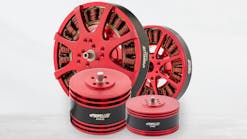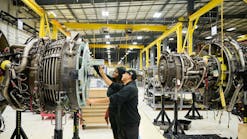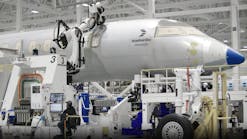DC9/MD80/737 Airstairs
The forgotten ones
By Greg Napert
September 2000
There was a time when the image of a passenger aircraft pulling up to a small terminal and deploying a futuristic-looking set of stairs was a common sight at an airport. For corporate and general aviation aircraft, it still is. But as passenger terminals developed and terminal Jetways and mobile stairways became commonplace; the need for airstairs became greatly diminished.
Aircraft such as the DC9, MD80, MD90, and 737 aircraft have had a long enough history that many of them were built with the forward passenger air stair assembly. As the need for them was reduced, later models were produced without forward airstairs. Many aircraft were also converted to non-airstair versions Ñ a 200+ lb. weight savings for the operator.
Regardless of the history, there continues to be a need for airstairs for specific operations. Freight operators, corporate conversions, and newer corporate variations of these aircraft such as the 717 still find air stair installations a necessity. The result is that there is still a need for maintenance and repair knowledge, replacement parts and qualified sources for overhaul.
Basic airstair description
The airstair installation, with some variations from aircraft to aircraft, includes four main components:
1. Forward and aft rail assembly
2. Carriage assembly
3. Electrical installations
4. Airstair assembly
The airstair assembly and the airstair door are powered with 115/200 VAC, 400 Hz, 3-phase power source located on the aircraft. The airstair installation and the airstair door may also be operated with a power source of 24 to 28 VDC.
Airstair assembly consists of two rigid beams connected to the ladder assembly, which also consists of the steps, hand-rails, lights, and wheels that allow the airstairs to seat firmly on the ground when extended. This is what extends from the carriage assembly to the ground for entering or exiting the aircraft.
One of the few facilities in the country that offer air stair overhaul services is Professional Aircraft Accessories. According to Joe Gramzinski, Chief Inspector for Professional Aircraft Accessories in Titusville, FL, "We have been servicing, repairing and overhauling airstairs that are installed on various aircraft including the DC-9, MD-80, MD-90, along with the 717 and 737 for over 10 years. Although some aspects of the overhaul can be a challenge, we can usually overhaul a standard airstair assembly within 30 days. This includes installing it on our universal test stand, this will allow us to give it a operational check and a complete visual inspection prior to teardown."
Of the many challenges related to overhauling some of this seldom used and often abused equipment, corrosion is a major factor in determining the overhaul requirements. Airstairs are exposed to the elements and experience a considerable amount of cracking due to widely varying stress and weight loads on the steps.
The forward and aft rails along with the handrails must also be disassembled, cleaned, inspected, parts and cables replaced if needed.
After all of these assemblies have been serviced and repaired, they will all be primed and painted (if applicable). New non-skid material is replaced on the stair steps. This material is
simply a stick-on adhesive that is pressed in position and then sealed with a sealant around the edges. This sealant prevents the non-skid material from pealing and prevents water from getting under and causing corrosion.
The unit is then assembled completely to the manufacturer's specifications for final testing and rigging, then shipped to the customers worldwide for installation onto their aircraft
or on their shelf as inventory.
In terms of the airstair actuator mechanism, McLean says, "We have occasionally replaced the chains and sprockets, but they are normally in pretty good condition. They have a tensioner on them that accounts for a considerable amount of wear. You can usually tell when they are stretched beyond limits due to the carriage binding and when adjustments are difficult to make. The chains are actually one of the more rugged components in the system, however. More than likely, a good cleaning, inspection, and lubrication are all that's required for these components in order to return it to service." Common problems One of the more common items that require a considerable amount of rework are the upper and lower enclosure assemblies. According to McLean, "There are wear strips that are located on the top enclosure where the stairs rub as they are retracted and extended. These wear strips will wear occasionally to the point that the edges stick up and if they catch on the stair assembly, they will peel the strips off of the cover and possibly cause binding." He continues, "Another occasional problem as well is the stops of the rear of the airstair that shut down the motors when it is retracted will also be damaged." On the stair that was in the shop during this story, the stops were completely broken off and the stair was hitting the back of the enclosure. This force alone was enough to shut down the stair. Unbeknownst to the operator, however, the stair would have eventually busted through the enclosure and then been jammed in place," he says. Vibration of the stair assembly is probably the biggest detriment to the entire assembly, second to corrosion. According to Stazenski, "We find many of the rivets and hardware items worn through or loose. Corrosion and delamination is definitely the biggest problem."
"We currently own three sets of airstairs that we are salvaging parts from to rebuild units," says Stazenski. "Keep in mind that the customer has the option of going with all new parts if they want to pay the price, but at least we give them the option of using serviceable parts for non-critical components."
How long does it take?
Depending on the situation, PAA can completely overhaul an assembly in five or six days. In reality, however, it takes a bit longer to process due to parts availability and work load. PAA ends up promising a 30-day turnaround period.
"The best scenario for our customers, and ourselves," claims Stazenski, "is to have our customers plan ahead and have at least one airstair assembly that is overhauled for AOG purposes. Then you never really end up with an AOG or rush situation because you
use the overhauled stair when you need it, and send in the backup for overhaul without putting a rush on it. In reality, what happens is we receive three at a time in and they're all AOG."
He continues, "One thing that the airline customers are pretty good at is lubricating the track and gear assemblies. We very rarely find one that is dry. Also, the lubrication really doesn't
have much of a chance to wash off - it's basically covered at most times on the top and bottom of the mechanism. We do find some interesting items inside the assembly between the top and bottom cover. Typically, these items, such as pens, hair pins, etc. fall into or are left on a stair and are pulled into the trays when the stair is retracted."
Basic advice
"In general, it's interesting how some of
the more basic maintenance is not done on these steps," explains Stazenski. "Simple, yet critical items such as the lights that are on the bottom of each step for lighting the stairway are often burned out or missing. Very rarely do we find them all operational. We simply replace all of the bulbs with new to make sure that the lighting lasts for a while. It doesn't take much to keep these stairs operational and a little care can go a long way towards reducing costs related to overhaul."













